
 |
| Agate Jewellery |
Scottish agates have been used in the manufacture of jewellery and other artifacts for more than two hundred years. Indeed, at the end of the eighteenth century Scotland was seen as an important source of semiprecious stones for this purpose both inside and outside the country. Early accounts suggest that agates and other materials were also used in the manufacture of buttons as well as being exported to London at that time. However, only a few items of jewellery utilising agate have been reliably dated to this period although brooches containing Scottish smoky quartz (Cairngorm) had been worn for several hundred years before this.
|
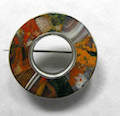 |
 |
 |
 |
 |
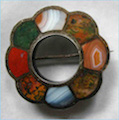 |
 |
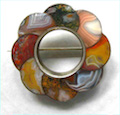 |
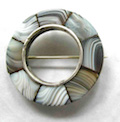 |
 |
Some of the jewellery was produced following the ancient annular (ring-shaped) and pen-annular (nearly ring shaped) forms but eventually a lot of the motifs were common elements of Victoriana deemed Scottish because of the characteristic use of Scottish stones. Banded grey and pink agates, onyx, carnelian and moss agates, red and yellow jaspers, bloodstone and pink and grey granites were favoured by the lapidaries. Silver mounts are much more common than gold. It is said that the quality of workmanship was better with the gold pieces but the agate itself looks better with silver. Very few pieces were signed before 1883 and hallmarking is a rarity making some of the pieces very difficult to date.
In recent years pebble jewellery has not been made in such quantity but scattered across Scotland are a number of lapidaries using local agates in their jewellery. Some examples are shown here made recently with agate from a number of the new localities. |
| Some Cabachons made with Scottish Agate |
 |
 |
 |
 |
 |
| Some examples of jewellery made by Maureen McDiarmid from Annan. Maureen has used agate material from a variety of recent localities here in Scotland, including some other less well known areas! |
 |
 |
 |
 |
 |
| All photographs here of Scottish Pebble Jewellery are reproduced here from "Scottish Pebble Jewellery - Its History and The Materials From Which It Was Made" by Nick Crawford |
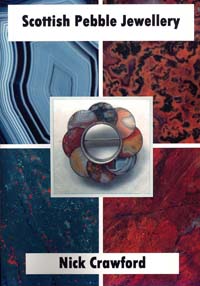 |
| This book describes the history of Pebble Jewellery, the sites from which the stones were collected, the manufacturing process used and the resulting types of jewellery. It is illustrated with more than 100 colour plates of collecting sites and pieces of jewellery. Unfortunately the book is no longer available but occasionally crops up second hand. |
| < Home |